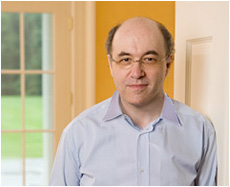
The announcement early yesterday morning of experimental evidence for what’s presumably the Higgs particle brings a certain closure to a story I’ve watched (and sometimes been a part of) for nearly 40 years. In some ways I felt like a teenager again. Hearing about a new particle being discovered. And asking the same questions I would have asked at age 15. “What’s its mass?” “What decay channel?” “What total width?” “How many sigma?” “How many events?”
When I was a teenager in the 1970s, particle physics was my great interest. It felt like I had a personal connection to all those kinds of particles that were listed in the little book of particle properties I used to carry around with me. The pions and kaons and lambda particles and f mesons and so on. At some level, though, the whole picture was a mess. A hundred kinds of particles, with all sorts of detailed properties and relations. But there were theories. The quark model. Regge theory. Gauge theories. S-matrix theory. It wasn’t clear what theory was correct. Some theories seemed shallow and utilitarian; others seemed deep and philosophical. Some were clean but boring. Some seemed contrived. Some were mathematically sophisticated and elegant; others were not.
By the mid-1970s, though, those in the know had pretty much settled on what became the Standard Model. In a sense it was the most vanilla of the choices. It seemed a little contrived, but not very. It involved some somewhat sophisticated mathematics, but not the most elegant or deep mathematics. But it did have at least one notable feature: of all the candidate theories, it was the one that most extensively allowed explicit calculations to be made. They weren’t easy calculations—and in fact it was doing those calculations that got me started having computers to do calculations, and set me on the path that eventually led to Mathematica. But at the time I think the very difficulty of the calculations seemed to me and everyone else to make the theory more satisfying to work with, and more likely to be meaningful.
At the least in the early years there were still surprises, though. In November 1974 there was the announcement of the J/psi particle. And one asked the same questions as today, starting with “What’s the mass?” (That particle’s was 3.1 GeV; today’s is 126 GeV.) But unlike with the Higgs particle, to almost everyone the J/psi was completely unexpected. At first it wasn’t at all clear what it could be. Was it evidence of something truly fundamental and exciting? Or was it in a sense just a repeat of things that had been seen before?
My own very first published paper (feverishly worked on over Christmas 1974 soon after I turned 15) speculated that it and some related phenomena might be something exciting: a sign of substructure in the electron. But however nice and interesting a theory may be, nature doesn’t have to follow it. And in this case it didn’t. And instead the phenomena that had been seen turned out to have a more mundane explanation: they were signs of an additional (4th) kind of quark (the c or charm quark).
In the next few years, more surprises followed. Mounting evidence showed that there was a heavier analog of the electron and muon—the tau lepton. Then in July 1977 there was another “sudden discovery”, made at Fermilab: this time of a particle based on the b quark. I happened to be spending the summer of 1977 doing particle physics at Argonne National Lab, not far away from Fermilab. And it was funny: I remember there was a kind of blasé attitude toward the discovery. Like “another unexpected particle physics discovery; there’ll be lots more”.
But as it turned out that’s not what happened. It’s been 35 years, and when it comes to new particles and the like, there really hasn’t been a single surprise. (The discovery of neutrino masses is a partial counterexample, as are various discoveries in cosmology.) Experiments have certainly discovered things—the W and Z bosons, the validity of QCD, the top quark. But all of them were as expected from the Standard Model; there were no surprises.
Needless to say, verifying the predictions of the Standard Model hasn’t always been easy. A few times I happened to be at the front lines. In 1977, for example, I computed what the Standard Model predicted for the rate of producing charm particles in proton-proton collisions. But the key experiment at the time said the actual rate was much lower. I spent ages trying to figure out what might be wrong—either with my calculations or the underlying theory. But in the end—in a rather formative moment for my understanding of applying the scientific method—it turned out that what was wrong was actually the experiment, not the theory.
Continue reading (Long read) - A Moment for Particle Physics: The End of a 40-Year Story?
No comments:
Post a Comment